-

人教版新目标初中英语八年级下册Why don’t you get her a scarf教案
教师带领学生复习有关描述宠物的词汇,采用教师提问学生回答的方进行。如:T:What animals do you think would be good pets?What animals do you think would be bad pets?What do you think are good animals for a six-year-old child?然后学生进行 pairwork 练习。Task two: 师生互动,学习探究 1、播放3a部分的录音,引导学生一边听录音,一边跟读。2、通过听录音学生回答以下问题:Why do you think pot-bellied pigs are popular?What are the advantages and disadvantages of keeping such a pet?教师对学生的回答进行及时点评。3.学习范文,学习重点短语,为下步的模仿写作提供语言素材。T :1. )Have you ever kept a pig as a pet?Do you like pigs? St.:No.…Why don’t you like to keep a pig? St: No.They’re too dirty and lazy(Do you know in some foreign countries like Hollyland, Australia,pigs are the most popular pet.there’s a kind of pig.(图)it has an interesting name? it ‘s called a pot-bellied pig.) Now,let’s learn an article about this kind of interesting pet.2.)play the tapeSt.:Listen and repeat3.)show some Qs on computer(本子St.: read silently,then answerthe Qs(本子)4.)Ask ss. Close book and retell this passage.(what is a pot-bellied pig? Is it a good or bad pet? ) St.: retell it to each other“A pot –bellied pig is a popular pet now…”5.read the article together.St.:.practice reading

人教版新目标初中英语八年级下册Would you mind turning down the music教案
Step 4. Group work (4)1. Ask a pair of students to read the dialogue. Say, This activity provides speaking, listening and writing practice using the target language.2. Ask students to complete the work in groups.3. Check the answers with the whole class. 4. Explain some of the language points. Step 5. Word review (Self check 1)1. Ask students to read the words and the phrases given. 2. Fill in the blanks with proper forms of these words to complete the sentences. 3. Check the answers with the whole class. Homework:Do activity 2 on page 57 after class. Period 6Teaching aims: 1. Teach vocabulary words and the useful expressions. 2. Enable the students to learn etiquette in different culture. 3. Help the students learn how to behave politely in public places and in daily life. Teaching procedures:Step 1. RevisionHelp students to review the function of making requests through a free talk. Then lead them to the topic of etiquette. Explain the meaning of etiquette. Or, ask students to look it up in the dictionary. Step 2. Pre-reading (Section 1)1. Ask students to read the picture and make a list with their partner about how many rules of etiquette can be seen being broken.

人教版新目标初中英语九年级上册I like music that I can dance to教案
教学目标: 1. Express preferences2. Talk about one’s likes and dislikes and the reasons3. Learn to express one’s opinions 4. Learn to write a reply 语言功能: 1) Talk about one’s preferences, using t he relative clause2) Talk about people’s likes and dislikes and the reasons3) Talk about opinions语言结构: Relative clauses with that and who语言目标:What kind of music do you like?I like music that I can sing along with.I love singers who write their own music.We prefer music that has great lyric.重点词汇及短语:heart, photography, interest, class, whatever, miss, okay, expect, sweet, taste, itself, laboratory, cancer, increase, biscuit, main, care, prefer… to…, remind somebody of …, dance to, sing along with, be sure to, interest somebody, make somebody adj., to be honest, suit somebody, on display, catch up教学重难点:What do other people think of the different kinds of things? How to express one’s opinions? 学习方式:讨论,合作学习情感目标:通过本单元的学习,能提高学生的艺术鉴赏能力和审美情趣,并引导学生养成健康的饮食习惯。课时安排5课时第一课时:Section A: 1a-2c第二课时:Section A : 3a-4第三课时:Section B:1-2c, Self check2第四课时:Section B: 3a-4, Self check1第五课时:Self check ReadingI like music that I can dance to.

人教版新目标初中英语九年级上册I used to be afraid of the dark教案
内容提示1.本单元主要内容是学会used to结构。Used to +动词原形表示过去经常、以前常常,只用于过去式中,用来表示现在已不存在的习惯或状态。例如:They used to play football together.他们过去常在一起蹋足球。(现在不在一起踢了)2.used to的疑问形式和否定形式为Did you use to…?和I didn’t use to… 也可以用Used you to…?和I used not to…但现在多使用前者。例如:Did you used to swim in the river? 你过去常在河里游泳吗?I didn’t use to play the piano. 我以前并不经常弹钢琴。教学目标一、学习目标(Language Goal) 1.学会陈述自己过去常做的事情。2.学会陈述自己过去的爱好等。3.能够表达自己现在和过去在外表、性格、娱乐等方面的变化。4.能够表达朋友、家人等现在和过去的变化。二、语言结构(Language Structures) 1.I used to be short when I was young. 我年轻时个子很矮。 2. —Did you use to have straight hair? 你过去是直发吗?—Yes, I did. 是的。 3. —Did you use to play the piano? 你过去弹钢琴吗?—No, I didn’t. 不,我不弹。 4.I used to be afraid of dark. 我过去害怕黑暗。 5.I’m terrified of the snakes. 我害怕蛇。

人教版新目标初中英语九年级下册By the time I got outside, the bus had already left教案
Ⅰ. Teaching Aims and Demands1. Knowledge Objects(1) Key Vocabularyoversleep(2) Target LanguageWhat happened?I overslept. And by the time I got up, my brother had already gotten in the shower.2. Ability Objects(1) Teach the students to use the new words.(2) Train the students to narrate past events with the Past Perfect Tense.(3) Train the students' listening and speaking skills with the target language.3. Moral ObjectIt’s a good habit to go to bed early in the evening and get up early in the morning. So you’ll never be in a hurry in the morning.Ⅱ. Teaching Key Points1. Key Vocabularyoversleep2. Target LanguageNarrate past events with the Past Perfect TenseⅢ. Teaching Difficult Points1. Train the students to narrate past events with the Past Perfect Tense.2. Train the students to understand the target language in spoken conversation.Ⅳ. Teaching Methods1. Thinking of examples from the students' real lives.2. Making sentences by looking at the pictures.Ⅴ. Teaching AidA tape recorderⅥ. Teaching ProceduresStep I Revision1. Revise the language points in Unit 8.Ask some questions like this: What volunteer work would you like to do?Help the students to answer, I’d like to…/I love to…/I hope to2. Practice the dialogue in Activity 3c on page 62 again. Get students to role play the similar dialogues with the following.

人教版新目标初中英语九年级上册It must belong to Carla教案
一、Section A该部分有4个模块。第一模块围绕Whose volleyball is this? 这一话题展开思维( 1a)、听力(1b)、口语( 1c)训练;第二模块围绕上一模块中的话题进行听力( 2a-2b)、口语训练( 2c);第三模块继续围绕前两个模块中的“making inferences”展开训练。训练形式为阅读排序( 3a)和两人问答(3b);第四模块仍就上一话题展开讨论。二、Section B该部分有4个模块。第一模块要求根据图画和所提供的单词写出合理的句子;第二模块在听力( 2a-2b)和分角色口语训练( 2c)的基础上,继续进行“推测”训练; 第三模块围绕“Strange events in Bell Tower neighborhood”这一话题展开阅读( 3a)和写作(3b -3c)训练;第四模块以dream为话题展开小组活动。三、Self Check该部分有3个模块。第一模块以填空形式对所学词汇进行训练;第二模块就8个谚语展开阅读和讨论。

人教版新目标初中英语九年级下册Rainy days make me sad教案
1. 教材分析本单元以how do things affect you?为话题, 从颜色、天气、音乐、广告、产品等方面谈论了外界事物如何影响人的心情。要求学生掌握表达某物或某事给人带来的感觉、看法或影响等。共设计了四个部分的内容:Section A 该部分有4个模块:第一模块围绕Which restaurant would you like to go to?这一话题展开思维(1a)、听力(1b)、口语(1c)训练;第二模块围绕How does music affect you? 进行听力(2a-2b)、口语训练(2c);第三模块继续围绕how do colors in the restaurant affect you这一话题展开训练,训练形式为阅读和问题体验(3a)和小组活动(3b);第四模块仍就How do things affect you这一话题以调查的形式展开讨论。Section B该部分有4个模块:第一模块围绕产品广告对人们的影响这一话题以“配对”(1a)与“列举”(1b)两种形式展开训练;第二模块继续围绕How do things affect you? 进行听力(2a-2b)、口语对话训练(2c);第三模块围绕“Advertising”这一话题展开阅读(3a-3b)和写作(3c)训练;第四模块围绕How posters affect you这一话题以口语训练形式展开小组活动。

人教版新目标初中英语九年级下册Could you please tell me where the restrooms are教案
Step Ⅰ RevisionCheck homework. Ask a few students to read the article in 3a.Then ask a few students to read their guides.Step Ⅱ Part 1Look at the words in the box. Ask a student to read them. Make sure the students understand the meaning of the words. You are to fill in the blanks with the words. In some cases, students may need to use another form of the word, for example adjusting for tense or subject/ verb agreement.Ask students to fill in the blanks on their own.Check the answers. Step ⅢPart 2Go through the instructions with the class.Look at the example with the students.Ask students what the answer would be.Ask a student to read the question and answer it.Excuse me, could you tell me where the bank is, please?The bank is across the street from the shopping malt.Get students to complete the work in pairs.Check the answers. Ask a few students to read their questions.Step Ⅳ Just for Fun!Ask all the students to read the conversation. Ask: What is funny about this cartoon? Help students to explain. A Martian is a person from the planet Mars.There is no such thing as Martian food on Earth, and the clerk looks silly because he is trying to think of where there is a Martian restaurant.Invite some pairs of students to present this conversation to the rest of the class.Step Ⅴ Summary and HomeworkIn this class, we’ve done much writing practice using the key vocabulary words and the target language presented in this unit. After class, please finish the questions in 2 in your exercise books. Then finish the exercises on pages 47~48 of the workbook as well.The Seventh Period Ⅰ Teaching Aims and Demands1. Knowledge Objects(1) Key Vocabularyimage, adventure, jealousy, hero, crime, journey, brave, no longer, show interest in, take it easy, become interested in, plain looks(2)Text:Grown-ups like cartoons, too.2. Ability Objects(1) Fast-reading to get a general idea of the text.(2) Careful-reading to get the detailed information in the text.

人教版新目标初中英语九年级下册I’ll help clean up the city parks教案
Talk about offering help (P60)I’ll help clean up the city parks.A: I’d like to work ...B: You could help ...Talk about ways to tell people about the Clean-Up Day (P61)We need to ...We can’t ...I’ll ...Talk about the work the volunteers do (P62)These three students all volunteer their time to help other people.Somebody loves to ... / helps ... / plans to ... / wants to ...A: What do you like doing?B: I like ... A: What kind of volunteer work do you think I could do?B: You could ...1. 重点词汇advertisement, fix, repair, pleasure, blind, deaf, shut, carry, specially, fetch2. 认读词汇hunger, homeless, cheer, clean-up, sign, establish, major, commitment, elementary, veterinarian, coach, similar, call-in, strategy, disabled, organization, unable, support, appreciate, donation, part of speech, pronoun, adverb, preposition, conjunction, donate, Jimmy, Sally3. 词组clean up, cheer up, give out, put off, set up, think up, take after, fix up, give away, put up, hand out, work out, at once

人教版新目标初中英语九年级下册You’re supposed to shake hands教案
教学目标:1. 掌握本单元一些重点词汇的写法和用法。2. 学会自如谈论餐桌礼仪。Step 1 RevisionAsk some students to retell the customs at the table in France in the passage in 3a.Step 2 Self checkPart 1. Fill in each bland with the correct word given. Students do the exercises by themselves at first. Then check the answers. Ask the students to comprehend the sentences and help them point out uses of some words, like “arrive (at / in) sw., spend time / money on sth , spend time / money (in) doing sth.”Part 2. Read about Fan Ling’s experience in a western restaurant. Understand the passage. Point out some key points in the passage.1. be / get used to doing sth. 习惯做某事2. begin with = start with 以….开头3. crowd v. 挤满,塞满 the crowd 人群 crowded adj. 拥挤的Then students discuss about how she would solve her problem. Ask some to share their stories with others.Part 3. Complete the crossword by looking at the sentences on the left. Then check the answers.
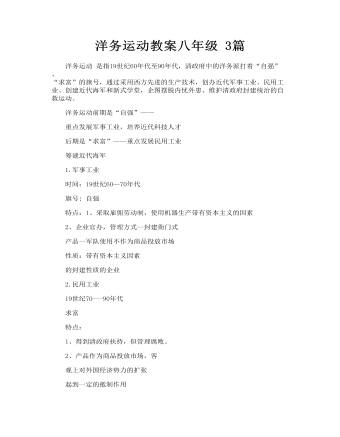
洋务运动教案八年级 3篇
1.军事工业 时间:19世纪60—70年代 旗号: 自强 特点:1、采取雇佣劳动制,使用机器生产带有资本主义的因素 2、企业官办,管理方式--封建衙门式 产品--军队使用不作为商品投放市场 性质:带有资本主义因素 的封建性质的企业
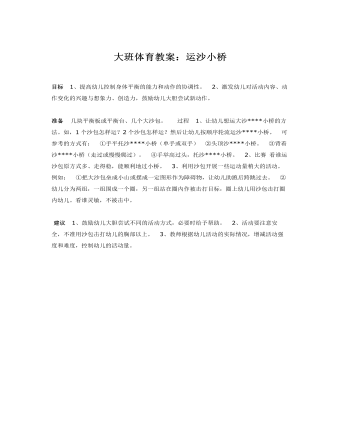
大班体育教案:运沙小桥
准备 几块平衡板或平衡台、几个大沙包。 过程 1、让幼儿想运大沙****小桥的方法。如,1个沙包怎样运?2个沙包怎样运?然后让幼儿按顺序轮流运沙****小桥。 可参考的方式有: ①手平托沙****小桥(单手或双手) ②头顶沙****小桥。 ③背着沙****小桥(走过或慢慢爬过)。 ④手举高过头,托沙****小桥。 2、比赛看谁运沙包原方式多、走得稳,能顺利地过小桥。
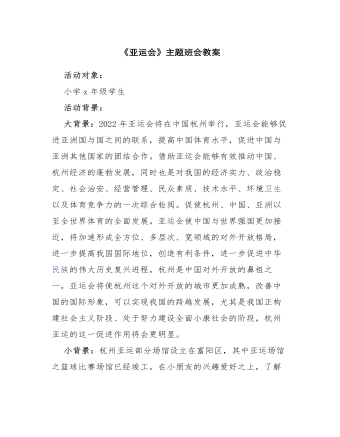
《亚运会》主题班会教案
生1重新组织语言,进行更清楚的讲解。师:现在听了你的介绍我一定能很快找到厕所。师小结:向导要让参观人员明确参观地的同时还要让他感受到这个地方的文化与美丽。(板书:明确文化)【设计意图:用游戏这种孩子们非常喜欢的形式入手,内容也是学生熟悉的校园环境,既活跃了课堂气氛又使学生在游戏中明白了向导是要让参观人员明确参观地的同时还要让他感受到这个地方的文化与美丽。】二、视频、解说近亚运场馆之篮球比赛馆1.听教师介绍师:同学们,2022年亚运会将在杭州举行,很荣幸富阳作为场馆提供地也参与其中,能够让国内外的游客看到我们的家乡。而这些游客对富阳亚运场馆还不够了解,他们在游玩过程中也许会遇到一些场馆导向问题,今天我们就要来做做主人,带他们了解富阳的亚运场馆之篮球比赛馆。
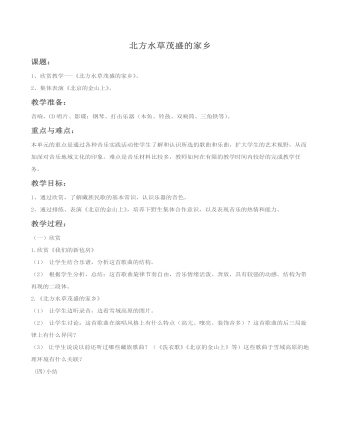
《北方水草茂盛的家乡》教案
课题:1、欣赏教学---《北方水草茂盛的家乡》。2、集体表演《北京的金山上》。重点与难点:本单元的重点是通过各种音乐实践活动使学生了解和认识所选的歌曲和乐曲,扩大学生的艺术视野,从而加深对音乐地域文化的印象。难点是音乐材料比较多,教师如何在有限的教学时间内较好的完成教学任务。教学目标:1、通过欣赏,了解藏族民歌的基本常识,认识乐器的音色。2、通过排练、表演《北京的金山上》,培养下野生集体合作意识,以及表现音乐的热情和能力。教学过程:(一)欣赏1.欣赏《我们的新毡房》(1) 让学生结合乐谱,分析这首歌曲的结构。(2) 根据学生分析,总结:这首歌曲旋律节奏自由,音乐情绪活泼、奔放,具有较强的动感。结构为带再现的二段体。2.《北方水草茂盛的家乡》(1) 让学生边听录音,边看雪域高原的图片。(2) 让学生讨论:这首歌曲在演唱风格上有什么特点(高亢、嘹亮、装饰音多)?这首歌曲的后三局旋律上有什么异同?(3) 让学生说说以前还听过哪些藏族歌曲?(《洗衣歌》《北京的金山上》等)这些歌曲于雪域高原的地理环境有什么关联? (四)小结
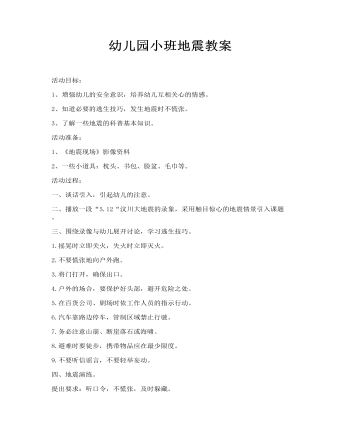
幼儿园小班地震教案
二、播放一段“5.12“汶川大地震的录象,采用触目惊心的地震情景引入课题。三、围绕录像与幼儿展开讨论,学习逃生技巧。1.摇晃时立即关火,失火时立即灭火。2.不要慌张地向户外跑。3.将门打开,确保出口。4.户外的场合,要保护好头部,避开危险之处。5.在百货公司、剧场时依工作人员的指示行动。6.汽车靠路边停车,管制区域禁止行驶。
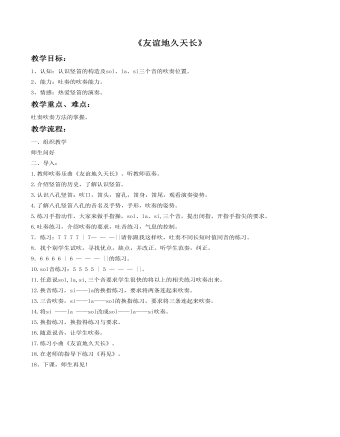
《友谊地久天长》教案
教学流程: 一、组织教学师生问好二、导入:1.教师吹奏乐曲《友谊地久天长》。听教师范奏。2.介绍竖笛的历史,了解认识竖笛。3.认识八孔竖笛:吹口,笛头,窗孔,笛身,笛尾,观看演奏姿势。4.了解八孔竖笛八孔的音名及手势,手形,吹奏的姿势。5.练习手指动作,大家来做手指操,sol、la、si,三个音,提出闭指,开指手指尖的要求。6.吐奏练习,介绍吹奏的要求,吐音练习,气息的控制。7.练习:7 7 7 7 | 7———||请你跟我这样吹,吐奏不同长短时值同音的练习。8.找个别学生试吹,寻找优点,缺点,并改正。听学生范奏,纠正。9.6 6 6 6 | 6 ——— ||的练习。10.sol音练习:5 5 5 5 | 5 ——— ||。11.任意说sol,la,si,三个音要求学生很快的将以上的相关练习吹奏出来。12.换音练习,si——la的换指练习,要求将两条连起来吹奏。13.三音吹奏,si——la——sol的换指练习,要求将三条连起来吹奏。14.将si ——la ——sol改成sol——la——si吹奏。15.换指练习,换指得练习与要求。16.随意说音,让学生吹奏。17.练习小曲《友谊地久天长》。18.在老师的指导下练习《再见》。18、下课,师生再见!
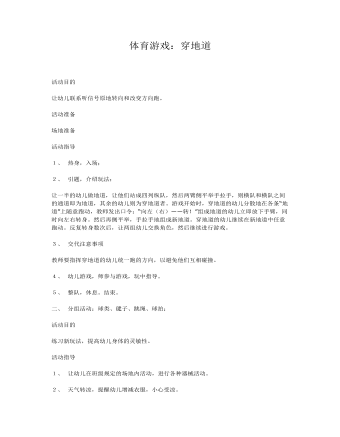
体育游戏:穿地道课件教案
2、 引题,介绍玩法;让一半的幼儿做地道,让他们站成四列纵队,然后两臂侧平举手拉手,则横队和横队之间的通道即为地道,其余的幼儿则为穿地道者。游戏开始时,穿地道的幼儿分散地在各条“地道”上随意跑动,教师发出口令:“向左(右)――转!”组成地道的幼儿立即放下手臂,同时向左右转身。然后再侧平举,手拉手地组成新地道。穿地道的幼儿继续在新地道中任意跑动。反复转身数次后,让两组幼儿交换角色,然后继续进行游戏。3、 交代注意事项教师要指挥穿地道的幼儿统一跑的方向,以避免他们互相碰撞。4、 幼儿游戏,师参与游戏,玩中指导。5、 整队,休息。结束。
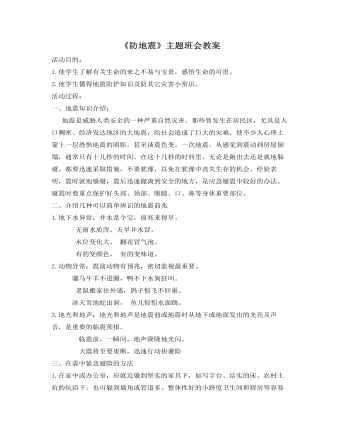
《防地震》主题班会教案
活动目的:1.使学生了解有关生命的来之不易与宝贵,感悟生命的可贵。2.使学生懂得地震防护知识及防其它灾害小常识。活动过程:一、地震知识介绍:地震是威胁人类安全的一种严重自然灾害。那些曾发生在居民区,尤其是人口稠密、经济发达地区的大地震,给社会造成了巨大的灾难,使不少人心理上蒙上一层恐惧地震的阴影,甚至谈震色变。一次地震,从感觉到震动到房屋倒塌,通常只有十几秒的时间。在这十几秒的时间里,无论是跑出去还是就地躲避,都要迅速采取措施,不要犹豫,以免在犹豫中丧失生存的机会。经验表明,震时就地躲避,震后迅速撤离到安全的地方,是应急避震中较好的办法。避震时要重点保护好头部、颈部、眼睛、口、鼻等身体重要部位。
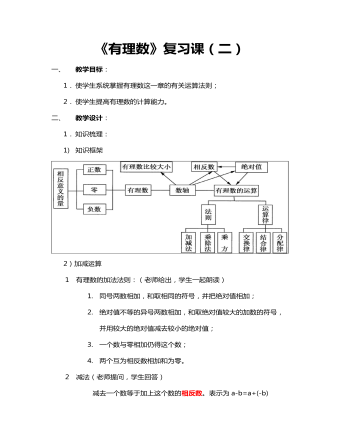
有理数复习教案教学设计
3)乘除运算①有理数的乘法法则:(老师给出,学生一起朗读)1. 两数相乘,同号得正,异号得负,并把绝对值相乘;2. 任何数与零相乘都得零;3. 几个不等于零的数相乘,积的符号由负因数的个数决定,当负因数有奇数个数,积为负;当负因数的个数为偶数个时,积为正;4. 几个有理数相乘,若其中有一个为零,积就为零。②有理数的除法法则:(老师提问,学生回答)1. 两个有理数相除,同号得正,异号得负,并把绝对值相除;2. 除以一个数等于乘以这个数的倒数。③关系(老师给出)除法转化为乘法进行运算。
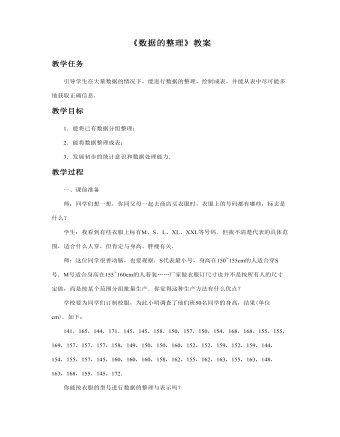
数据的整理教案教学设计
一、课前准备师:同学们想一想,你同父母一起去商店买衣服时,衣服上的号码都有哪些,标志是什么?学生:我看到有些衣服上标有M、S、L、XL、XXL等号码.但我不清楚代表的具体范围,适合什么人穿,但肯定与身高、胖瘦有关.师:这位同学很善动脑,也爱观察.S代表最小号,身高在150~155cm的人适合穿S号.M号适合身高在155~160cm的人着装……厂家做衣服订尺寸也并不是按所有人的尺寸定做,而是按某个范围分组批量生产.你觉得这种生产方法有什么优点?学校要为同学们订制校服,为此小明调查了他们班50名同学的身高,结果(单位cm).如下

